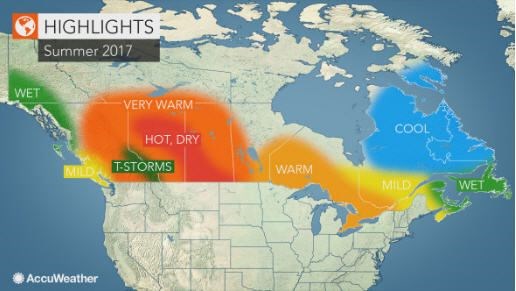Expect marginally-warmer weather this summer.
Temperatures should hover about 2 C above normal in B.C.'s Central Interior according to an AccuWeather long-range forecast. The service is also calling for a "fairly dry" summer.
AccuWeather meteorologist Brett Anderson said there are two reasons behind the forecast.
"The overall pattern supports high pressure sitting across Western Canada," he said. "That being the dominant feature, that would keep most of the Pacific front from going up into the Yukon and then coming back down across Eastern Canada.
"That would also mean that most of the cool air coming in from the north would be redirected and go down into Manitoba and Ontario over the course of the summer."
The second reason is the absence of the "Blob." The large area of warmer than average ocean water to the west of B.C. and south of Alaska dominated weather patterns for the last two years, sending warm but also wet weather in Western Canada.
"Now, the opposite is true this year," Anderson said. "The warm blob is gone and we're left with slightly-below-normal sea surface temperatures which would favour along the coast, at least, a cooler summer but it also reduced the amount of available moisture if they do make it in across the Central Interior."
Whether that will translate into a busy wildfire season, particularly in B.C.'s Northeast and into Alberta, where Anderson said it will be warmer still, remains to be seen.
"There are a lot of other variables we have to look at - you can't tell until it's right in front of your eyes whether it's going to be a bad fire season or not but - certainly what the forecast is showing gives you concern," Anderson said.
Vacationers thinking of heading to the southern portion of the Rockies may also have to brace themselves for a summer of thunder and lightning and possibly flash flooding.
"Even though you have a big area of high pressure building across the region, any moisture that comes up from the south - monsoonal moisture comes up for the southern U.S. - gets trapped in the pressure system and then the mountains create so much instability in the air," Anderson said.



